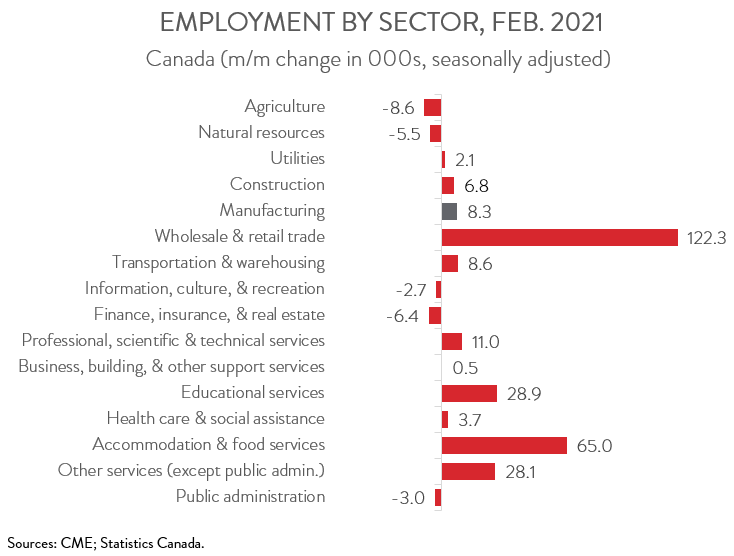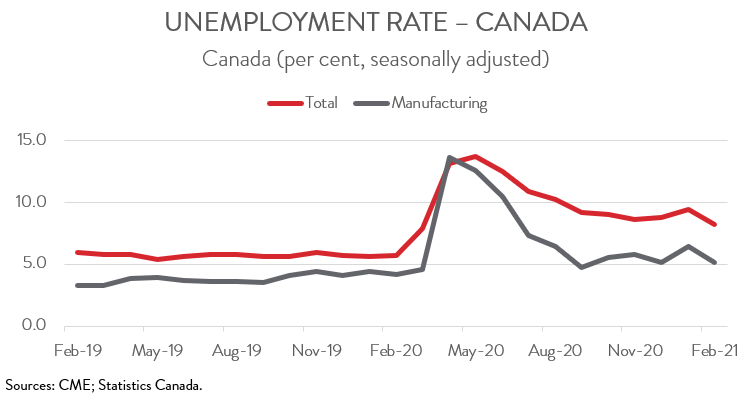Labour Market Trends
Labour Market Trends
February 2021
Canadian Employment Rebounds Sharply in February
HIGHLIGHTS
- Employment rose by 259,200 (+1.4 per cent) in February, following consecutive monthly declines totalling 265,500 (-1.4 per cent) over December and January.
- The employment increase spanned 11 of 16 major industries, with retail trade and accommodation and food services contributing the most to the gain.
- After shrinking by 12,300 (-0.7 per cent) in January, manufacturing employment increased by 8,300 (+0.5 per cent) in February.
- The unemployment rate fell from 9.4 per cent in January to 8.2 per cent in February, the lowest rate since March 2020.
- Employment was up in 7 of 10 provinces, with the gains concentrated in Quebec and Ontario.
- The job market rebound in February came as no surprise, as it coincided with the easing of public health measures. This provides further evidence that the Canadian economy fared better than expected during the first quarter. However, more transmissible variants of SARS-COV-2 appear to be taking hold in some regions, raising the spectre of another round of localized restrictions.
CANADA CREATES MORE THAN 250,000 JOBS
Employment rose by 259,200 (+1.4 per cent) in February, following consecutive monthly declines totalling 265,500 (-1.4 per cent) over December and January. However, even with this gain, about 600,000 Canadians who lost their jobs during the pandemic still had not returned to work as of February 2021. Also, about 406,000 more people were still working less than half their usual hours.

The job market rebound in February came as no surprise, as it coincided with the easing of public health measures in many provinces. That said, the magnitude of the increase was much larger than expected. This provides further evidence that the Canadian economy fared better than expected during the first quarter. However, more transmissible variants of SARS-COV-2 appear to be taking hold in some regions, raising the spectre of a third wave and another round of localized restrictions. This suggests that Canada’s labour market recovery will remain bumpy until a sufficient proportion of the population is vaccinated.
HIGH-CONTACT SERVICES SEE LARGE GAINS; MANUFACTURING ADDS 8,300 JOBS
Employment increased in 11 of 16 major industries in February, and not surprisingly, the bulk of the gains were in high-contact services that reopened following the easing of COVID-19-related restrictions. Retail trade led the way, with employment rising by 122,000 (+6.1 per cent). This gain represented a recovery of more than three-quarters of the employment losses in January.
The number of people working in accommodation and food services climbed by 65,000 (+7.8 per cent). Despite these gains, the sector has experienced the slowest recovery to-date. In February, employment in accommodation and food services was down 26.1 per cent compared to the same month a year ago.

The “other services” industry added 28,100 workers to payrolls, the first increase since September 2020. This sector includes personal care services, such as hairdressers, which were permitted to re-open in several provinces in early February.
After shrinking by 12,300 (-0.7 per cent) in January, manufacturing employment increased by 8,300 (+0.5 per cent) in February. With this rebound, the sector’s employment returned to its pre-COVID level.
The losses were comparatively modest in the five industries that shed jobs last month. More specifically, declines were recorded in agriculture (-8,600), finance, insurance, and real estate (-6,400), natural resources (-5,500), public administration (-3,000), and information, culture and recreation (-2,700).
UNEMPLOYMENT RATE FALLS TO LOWEST POINT SINCE MARCH 2020
The unemployment rate fell from 9.4 per cent in January to 8.2 per cent in February, the lowest point since March 2020. The jobless rate in the manufacturing sector also declined over the same period, falling from 6.4 per cent to 5.1 per cent.
On a negative note, the number of long-term unemployed—people who had been looking for work or been on temporary layoff for 27 weeks or more—continue to make up a growing share of the unemployment pool. This is bad news because generally, the longer someone is unemployed, the harder it is for that person to get another job.

JOB GAINS CONCENTRATED IN QUEBEC AND ONTARIO
Employment was up in 7 of 10 provinces in February. Ontario and Quebec were responsible for the bulk of the gains, one month after suffering the lion’s share of the losses. Employment in Quebec increased by 112,600 (+2.7 per cent). The gain was mainly in part-time work, with retail trade contributing most to the increase. Ontario added 100,300 (+1.4 per cent) jobs. Like Quebec, the jobs created were mostly part-time, with significant increases occurring in accommodation and food services and retail trade.
Employment also rose in BC (+26,600), Alberta (+16,800), and Manitoba (+16,200). On the negative side, employment fell by 15,000 (-6.8 per cent) in Newfoundland and Labrador, the second consecutive monthly decrease. Last month’s decline in Newfoundland and Labrador was expected, as the province was placed in lockdown on February 12. Employment was little changed in the remaining provinces.
Ontario accounted for the bulk of the job gains in manufacturing, with employment increasing by 15,000 (+1.9 per cent) last month. Manufacturers also added workers to payrolls in Quebec (+3,000), Manitoba (+1,700), and Saskatchewan (+1,200). On the other hand, notable decreases occurred in BC (-6,600), Alberta (-3,300), and New Brunswick (-2,100).
